The Story of Snow Leopard – Part Three: The Inaugural Flight
11 September 2013 Leave a comment
Part Three: The Inaugural Flight
Selling Tickets
With the Acceptance Flight completed and the aircraft ready to start operations, management and staff got into full gear. Tickets were sold, crews scheduled and plans were made for launch activities. At the London Headquarters on Kensington High Street, tickets sales in both the Delhi, India and Karachi, Pakistan markets was brisk and flights sold out very quickly. However, ticket sales in the Dushanbe market was slow due to very little western business activity in the country, and what little passenger traffic there was, was largely government in nature. Thus, selling seats in the beyond markets was necessary. As described in Part One, this “Sixth Freedom” operation enabled a profit on what would have been money losing flights. In fact, over 90-95% of the booked passengers were booked on flights to Delhi or Karachi. Deeply discounted advance purchase excursion tickets offered through local travel agents in the ethnic neighborhoods of London resulted in a huge response.
The Kensington High Street Headquarters served as both a ticket office and operations base with constant activity, day and night. This was punctuated with welcome and frequent visits by the Pan Am and Tajik flight crews.
Ticket Sales at Kensington High Street Office
Tajik Staff
Pan Am Flight Crews visiting Kensington High Street Headquarters
Cabin Crew Scheduling
While ticket sales and preparations for the inaugural flight were progressing, Gunilla Crawford and her team of flight attendants set about to organize crew scheduling and rotations. This was no easy task!
Cabin crew scheduling was a challenge for Gunilla. With no computers available, some creativity was required:
From Gunilla Crawford:
“We went across the street from the hotel to a gas station and bought four dinosaur-shaped erasers in four different colors. Each dinosaur represented a crew. And each crew consisted of two ex-Pan Am flight attendants and the rest Tajik. On a large poster board we plotted the four destinations, London, Dushanbe, Karachi and New Delhi. By moving the dinosaurs between the destinations we made sure nobody was scheduled from London, when in fact the crew member was in New Delhi!”
Cabin Crew Scheduling. In the left picture are Gunilla Crawford, Vince Rossi and Debbie Thornburg. In the right are Gunilla, Linda Morehouse and Vince. Note the colored dinosaurs!
From Vince Rossi, who worked on crew scheduling:
“Gunilla was responsible for the entire inflight programme. To that end, building and scheduling crews was an important component of her job. Four crews were required to staff the operation, with one or two crews on rotation back home. Each flight would be staffed with two Pan Am Pursers joined in the SP cabin by flight attendants from India for Hindi language as well as the wonderful Tajiks. Some Brazilian and French flight attendants who lived in London also joined.
“For aircraft plotting, crew staffing, scheduling and rest requirements, in the days before laptop computers with Excel spreadsheets, improvisation was needed. A long sheet of plotting paper was procured, along with 4 small rubber toy dinosaurs. Each dinosaur was numbered in pencil: crew/dinosaur 1, crew/dinosaur 2, etc…. An interpretation of a full week of aircraft movements and stations visited was marked on the plotting paper, with lines drawn as the days progressed marking the track of the aircraft from Heathrow through Dushanbe and on to Delhi or Karachi. When Gunilla said it was time to “run the dinosaurs”, we placed the numbered dinosaurs on the plotting paper, each one numbered and representing a crew at their respective locations across the system and ensured that legal rest requirements were met and staffing matched the projected aircraft movements. This method was used for the entire time of the operation.
“Often the dinosaurs were “run” on a coffee table in a dedicated crew lounge provided at our hotel on Bath Road near Heathrow, and crews from other carriers in the lounge would be amused watching the “run of dinosaurs. This system worked exceptionally well. No aircraft movement was impeded due to cabin staffing or crew rest issues for the entire operation. It is also important to note that the initial “pairings” were established in meetings with the Tajik crewmembers, who also had an idea of how they wanted their work patterns and layover times and points. I may be mistaken but India and Pakistan were potential visa issues for the Tajiks even for layovers.”
and . . . Catering
When Gunilla arrived in London, she was in for a surprise. In addition to heading up the cabin crew, there was another responsibility as well: Catering. She handled that in pure Pan Am fashion.
“We made appointments with Catering at Heathrow airport, we picked china for the First Class Service, silver ware, serving dishes, baskets and linens. The “old” Pan Am training came back in force and we would do the service in the name of that classic carrier.”
The food service to be offered was superb.
In First Class departing London, “Royal Doulton Service” included during the drinks service a choice of Hot Canapes including Chicken Kebab, Mushroom Cream Vol-au-Vent, Spring Roll, Basil Cashew Parmesan Tartlets and Asian Canapes of mixed pakoras and samosas. The Hors d’oeuvres offered a choice of Poached Salmon Medallion on Oakleaf lettuce with Diced Pepper and Cucumber Salad, or a Tomato Cup filled with Mayonnaise Lemon garnish or a Smoked Chicked Breast on Radicchio with Mandarin Orange and Cucumber or a Radish and Mixed Peppers Julienne, all with a Mixed Leaf Salad with Vinaigrette. For the entree, the choices were Curry Prawn Jalfrezi with fresh chopped Coriander, Rack of Lamb with Herbs and Fresh Rosemary Sprigs or Chicken Shirin Polo accompanied by Basmati Rice with Zereshk or Potato Sesame Croquettes and a choice of vegetables including Broccoli au Gratin Mornay or Steamed Mixed Vegetables with Baby Sweetcorn, Turned Carrots and Mange Tout.
For desert Gateau Chocolate Roulade with Orange Zest was followed by a cheese plate that included Camembert, Port Salut, Feta, Stilton, Brie with black grapes, black and green olives and celery batons. Ending the meal was a fresh fruit basket.
Prior to landing in Dushanbe the pre-arrival “hot breakfast was just as posh…It was like working the Pan Am Clippers again”, according to Vince Rossi one of the ex-Pan Am flight attendants.
The Inaugural Flight
As the day approached for Snow Leopard’s first revenue flight from London to Dushanbe and onwards to Karachi, the crews began assembling in London to prepare. For Gunilla, it was a happy reunion with the Tajik flight attendants who greeted their ex-Pan Am counterparts with “squeals and shouts of joy”. For the inaugural flight four ex-Pan Am were to work the flight, Robert Stewart, Tania Anderson, Linda Morehouse and Linda Oja. On the flight deck were Captain Ed Olasz, First Officer Jim Donahue and Flight Engineer Carl Meixal. In addition, two qualified captains were assigned to the flight.
Preparations for departure went into high gear. Nothing was overlooked. Everything was covered, from the accuracy of the manuals to training to CRM (crew resources management) with the Tajik flight attendants. Anything that could possibly happen, even the unpredictable, was discussed and thoroughly prepared for.
The excitement of flying again did not escape the ex-Pan Amers who were taking part in the operation. Snow Leopard’s first flight coincided almost to the date of the demise of their beloved Pan Am, some two years prior.
From Tania Anderson:
“I happily scribbled away in my diary, gushing about the thrill of flying with my cosmopolitan colleagues again. A few fondly remembered having flown with this particular 747SP before. Some of my co-workers had not flown since Pan Am’s demise. It had been nearly two years to the day that I had been on my last flight, a White House Press Charter, when we learned that we were bankrupt for good. Now as we gathered in the lobby of our London hotel for the first flight to Dushanbe, we all noted the sad anniversary coupled with the excitement of exploring a new airline together.”
At 2215 hrs on the date of the inaugural flight, Snow Leopard, designated 7J801, departed London Heathrow for Dushanbe. The spirit on board was one of joy and happiness.
From Tania Anderson:
“During the flight, I quickly noted that many of the passengers, who were going onto Karachi, were much less frenetic than the ones we used to fly on Pan Am. They were elated to be going home, either for a visit or permanently, for a reasonably priced airline ticket. One passenger actually asked if he could kiss me, and I reluctantly replied, “Well, Ok, but on my cheek!” I also noted in my diary that we were flying across Russian airspace which may not sound like a big deal but to someone who grew up during the Cold War when the former USSR was our mortal enemy, it was intriguing to me.
“The multi-national crew also bonded quickly. The Tajik flight attendants loved the fact that my name was Tania. Naturally assuming that I was Russian with a name like Tania, one actually commented that I spoke good fluent English for a Russian. Some of the Tajiks were dark with olive skin and Middle Eastern looks. Most were Muslim. Others were the opposite end of the spectrum with white skin and light eyes. They were usually Russian Orthodox.
“Among the Tajik flight attendants, there were three Irenas on the flight. Any time I said ‘Irena’, all three would whirl around simultaneously to see what I wanted. The Tajik flight attendants were absolutely delightful and so easy to get along with. They were also thrilled to have secured a job such as this with the opportunity to explore a bit of the world, especially London. Many of them had no transportation from their homes, so they simply walked miles to the airport to work these extraordinarily long flights. They went out of their way to tell us how their country was still in a lot of upheaval economically. In addition, Afghani insurgents were coming over the border to make trouble, and they wanted none of it. ‘Tania, we just all want peace and to be able to live our lives’, one told me.”
The Pan Am and Tajik Flight Crews
After a long flight into the night, Snow Leopard landed in Dushanbe.
From Tania Anderson:
“It was a cold, wintry, snowy day when we landed in Dushanbe to a zealous reception on the tarmac. After all, we were the first western aircraft to ever land in somewhat remote Tajikistan. I distinctly remember applause in the cabin upon our touchdown, but the local hoopla outside just about had me abandoning my jump-seat.
“With a dramatic back drop of steep snow-encrusted mountains, dozens of well-wishers had gathered on the tarmac in their traditional brightly-colored clothes. There was a band playing Russian instruments complete with long-nosed horns and big drums. Tajik national TV was there with their ancient equipment to record every single minute of the ceremonies and our arrival.”
The Reception at Dushanbe Airport
From Tania Anderson:
“Once on the blocks, the ground people enthusiastically boarded the plane, not only to welcome us, but to ask for a quick tour of the 747SP. Descending the spiral staircase, our pilots were given handsome home-made colorful robes to wear over their uniforms. Now that the door was open, I could observe the entire scene. Our pilots were quickly ushered down the stairs and off to the terminal for a reception including some local culinary treats whose identity was left to the imagination. Later one of them told me that the Tajiks had insisted that they shoot some vodka—maybe local moonshine—to celebrate the day. A bit horrified, our pilots made certain that the officials knew we still had another leg to fly to Karachi, but the general response was like, ‘So what?’
“Linda Oja and I stayed on the plane watching everything from L-1. Then something happened I shall never forget. As Linda squealed, ‘Oh, No!’ I saw some Tajiks dragging a sheep across the tarmac towards the Snow Leopard. It struggled the entire way, right up to the staircase, just as if it knew something lousy was about to occur. As they do in many countries, they sacrificed the sheep at the bottom of our stairs, directing the blood from his neck into a bowl. In the west we christen ships and airplanes with champagne, but now we were half way around the world in a land with customs very different than our own.
“Not long afterwards, the entire crew along with the ground people gathered in front of the aircraft for a memorable photo. Each of us was festooned with garlands of deep red-colored roses. They were velvet to the touch and their fragrance was heavenly, even against the cold blast of mid-winter.”
From Tania Anderson:
“Standing there on that frosty winter day, I felt a true sense of pride about our latest “operation.” In true Pan Am fashion, we had pulled ourselves up after the bankruptcy and were on the other side of the planet helping the struggling Tajiks with their burgeoning airline, begun with one beautiful 747SP.
“Flying on the Snow Leopard was another wonderful Pan Amigo adventure to add to my memoirs.”
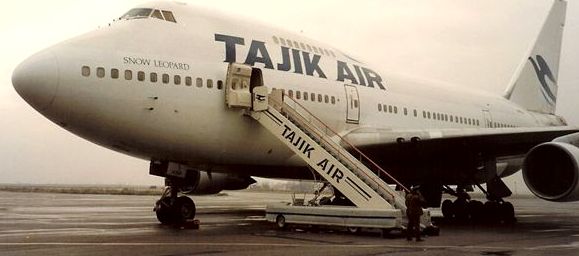
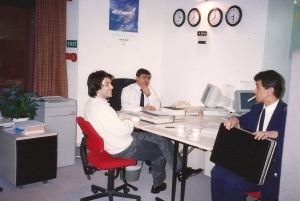

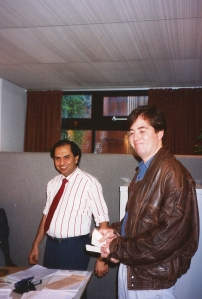
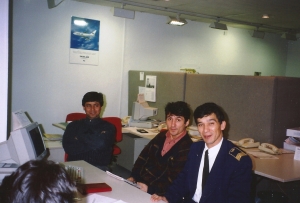
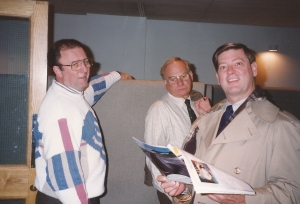
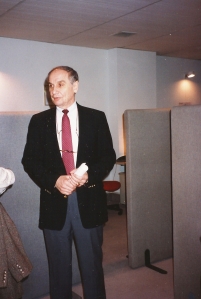
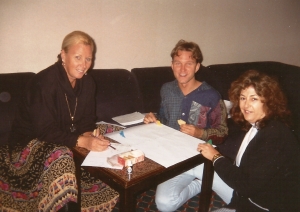
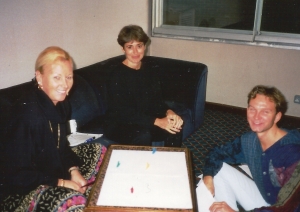
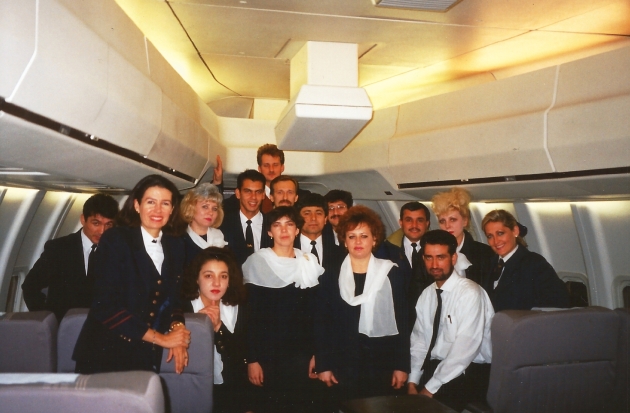
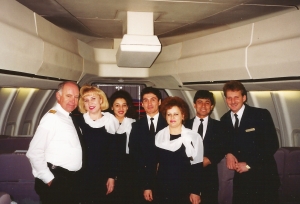
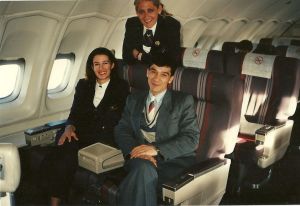
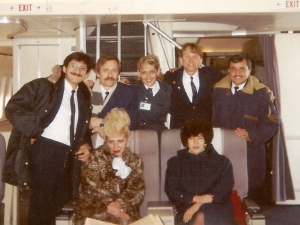
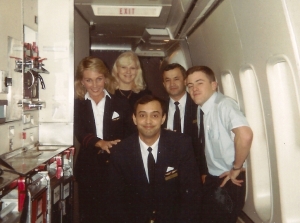
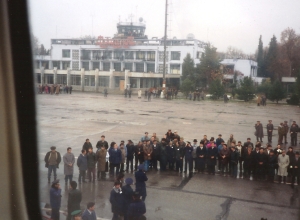
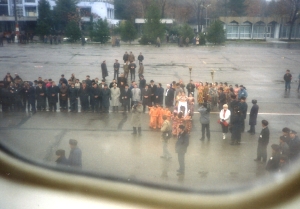

Recent Comments